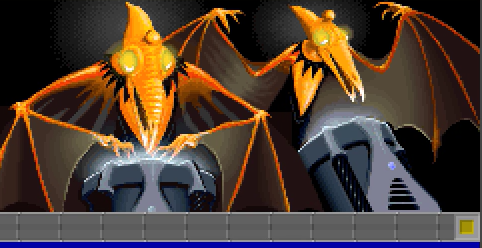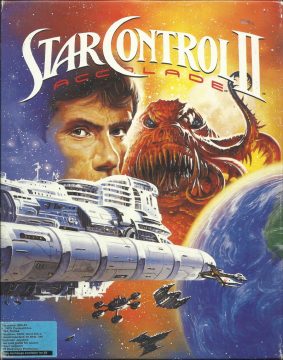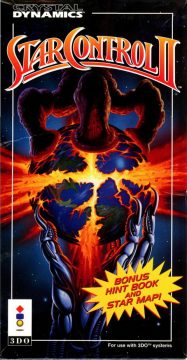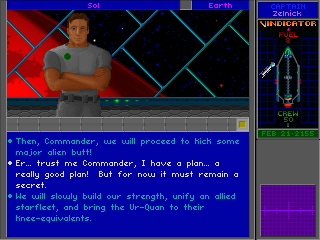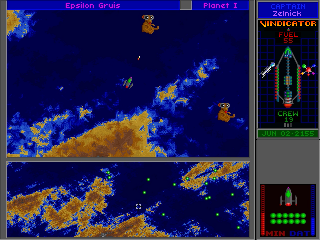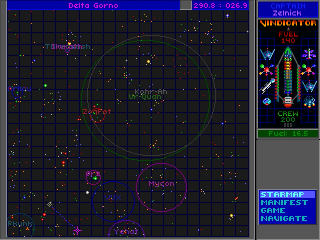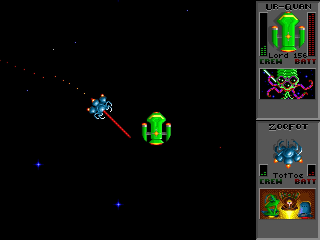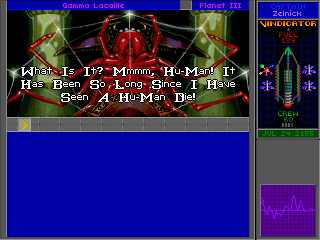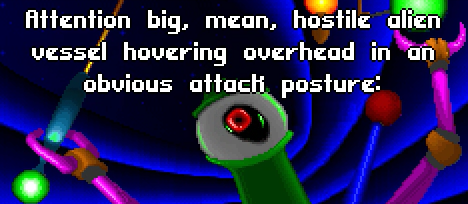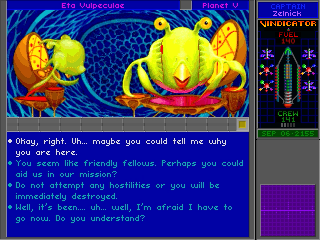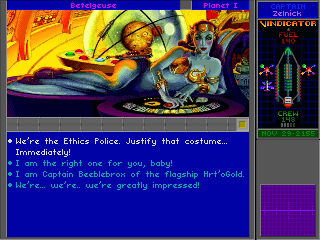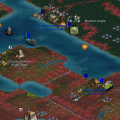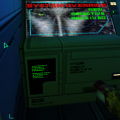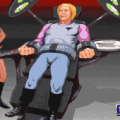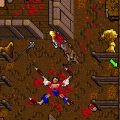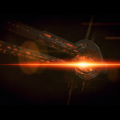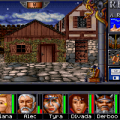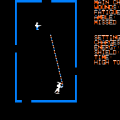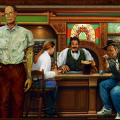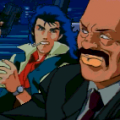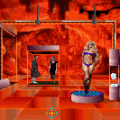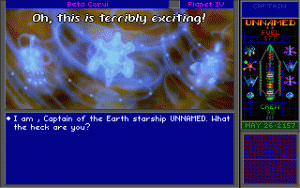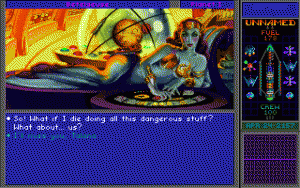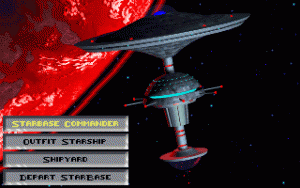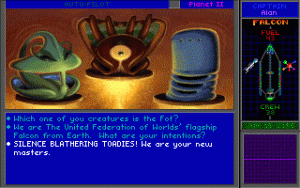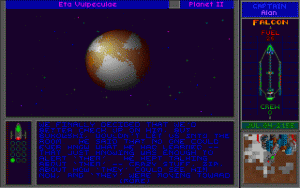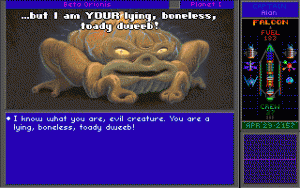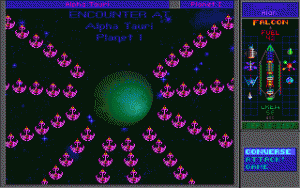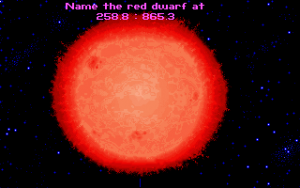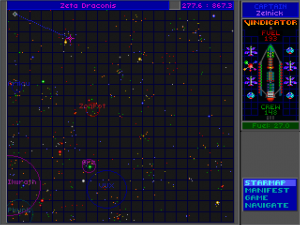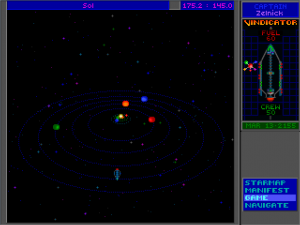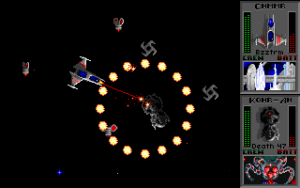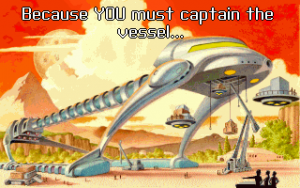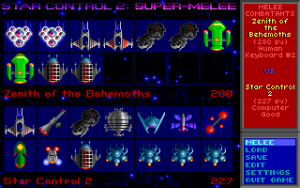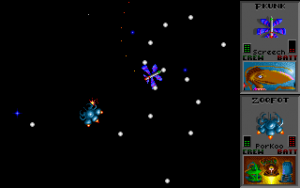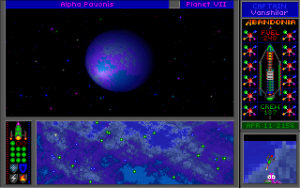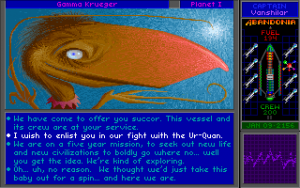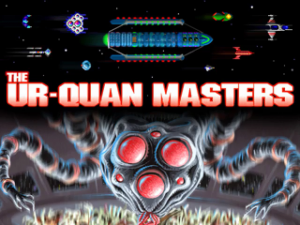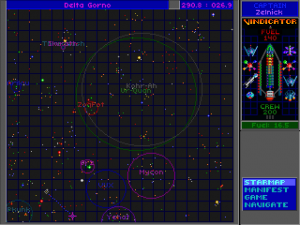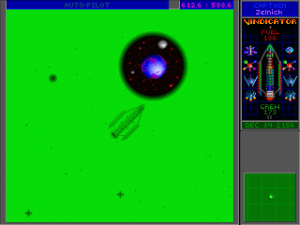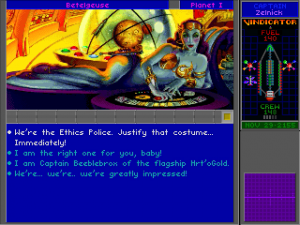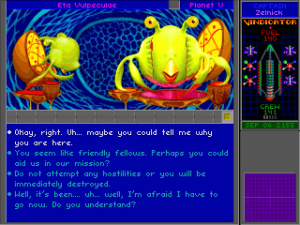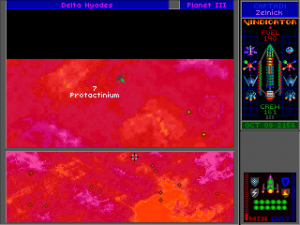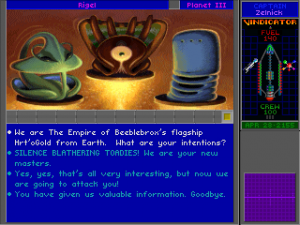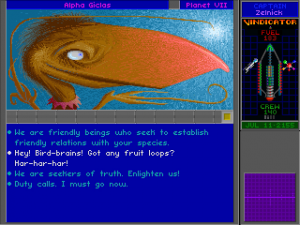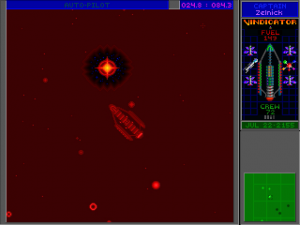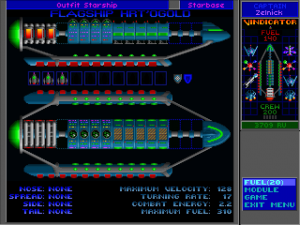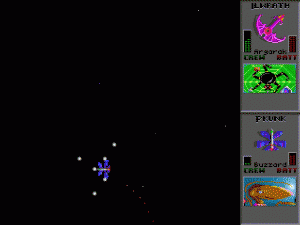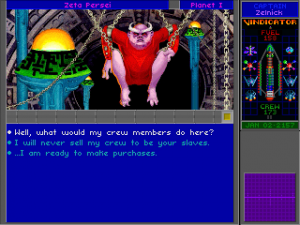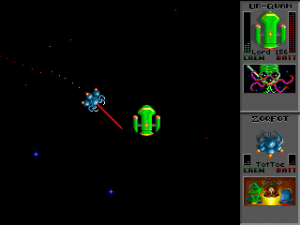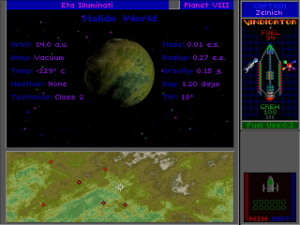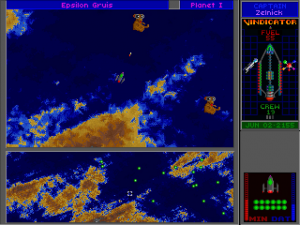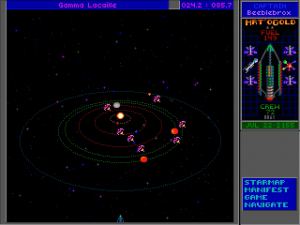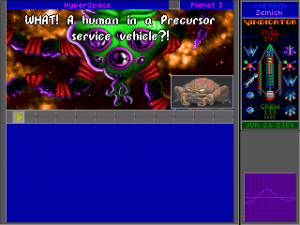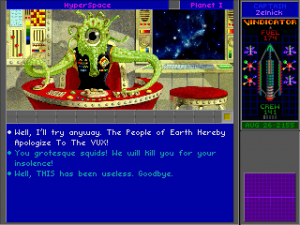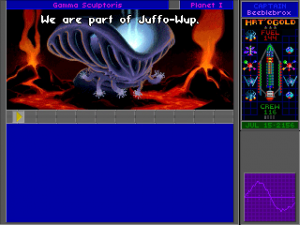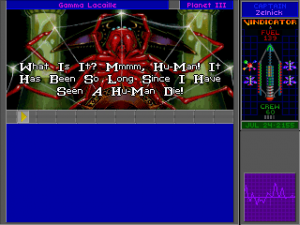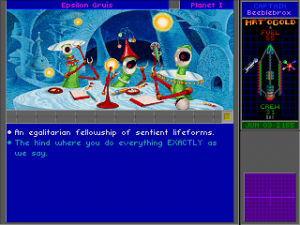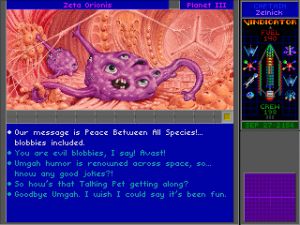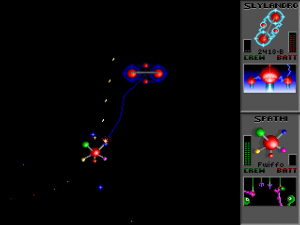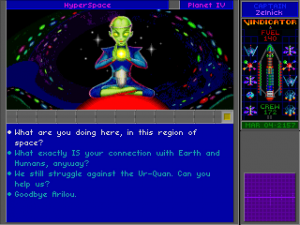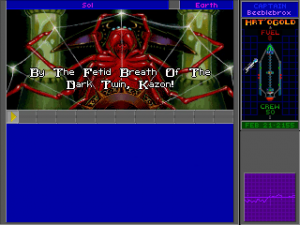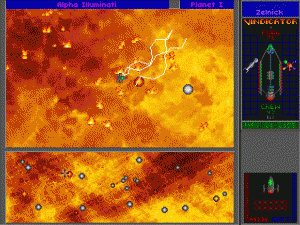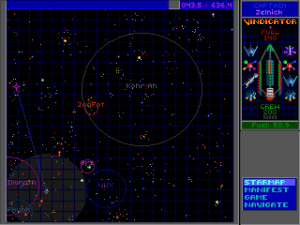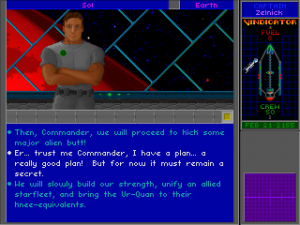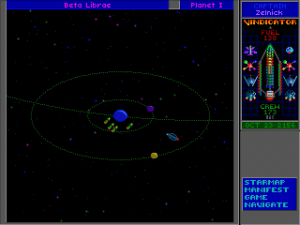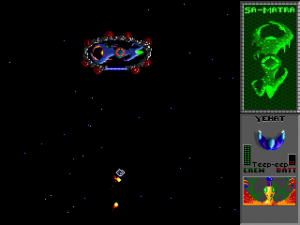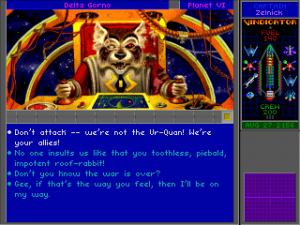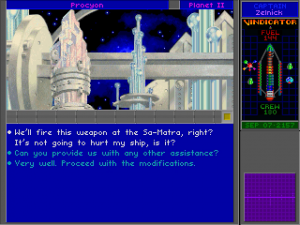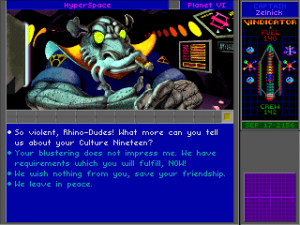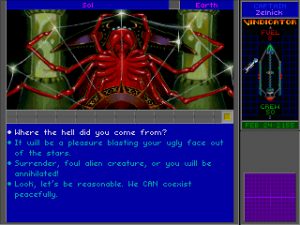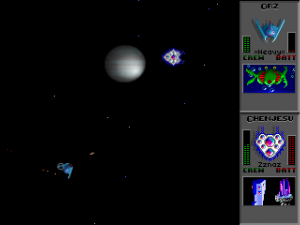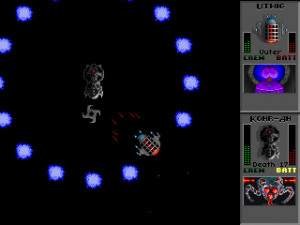Star Control II is a huge departure from the original. It takes the lore of the firstgame, which was largely relegated to the instruction manual, ditches the strategy elements and expands everything into one huge genre amalgamation. The core of the game – exploring the galaxy, gathering resources, running fetch quests – most closely resembles the Starflight games, designed by Greg Johnson. Some elements are stripped back (primarily the trading elements) while others (the writing and story, as well as the combat) are bolstered and improved. Also, while Starflight had an amusing set of aliens, you didn’t really interact with them all that much. Star Control II takes all of the backstory that was written for the first game, and more fully represents that here, with much more dialogue and branching conversations that recall LucasArts adventure games. And, perhaps most importantly, combat is handled in exactly the same ship-to-ship fighting as the first game, the only gameplay element to be carried over. So, this is not only a sequel to Star Control, but could also be seen as an unofficial Starflight III (at least, before an actual Starflight III began proposed development many years later in 2018).
The story of Star Control II is a dark one – the war from the first game has ended, and the Alliance has fallen to the Hierarchy. The nations of the Alliance are granted two options: they can either be forced into slavery as combat thralls but retain some semblance of autonomy in outer space travel, or all members sentenced to live on their homeworld, encased in a glowing red shield, forbidden from ever taking to the skies. Earth chooses the latter option.
Before this grim end, however, humanity had sent a small research vessel on a secret mission to the far-off Vela star system. They are stranded for quite some time, cut off from communications with the rest of the galaxy, but begin a small colony, and eventually unearth a giant starship factor left by the Precursors, an ancient race which has mysteriously disappeared from existence. After getting it into working order, they build a spaceship and return to Earth, only to discover how their side lost the war. You control the commander of the Precursor ship, who convinces the Earthlings to begin covertly supporting a revolution. Then you begin cruising the galaxy to reunite the remnants of the old Alliance, discover new races to aid the cause, and take down the Ur-Quan empire. Some of them, like the Earthlings, were encased in a slave shield, while you’ll fight the others when you encounter them…at least, until you convince them to join you.
Obviously, revolutions take a bit of work to get going. The galaxy in Star Control II is huge, consisting of hundreds of stars, which in turn consist of numerous planets and moons. You can travel between them through hyperspace, which requires fuel, plus you also need to be able to create ships to use in combat, as well as enhance and improve your flagship. Both of these requires Resource Units, or RUs, which are obtained by mining various planets throughout the galaxy. Upon entering orbit, you send down a tiny scout vessel to the planet surface, picking up little dots that represent mineral caches, then return to the home base at Earth to change them into RUs.
For as amazing as Star Control II ultimately is, this part is easily the weakest part of the game. It’s incredibly tedious, because out of the hundreds of planets that can be visited, many are gas giants, which are functionally useless since they have no surface to land on, or contain weather conditions that make it incredibly hard to gather stuff without getting your lander destroyed. Controlling the lander itself is a pain, considering it uses relative controls (up goes forward, down goes backward, left and right turn) making it difficult to avoid getting crushed. In the original PC version, the action window is incredibly small, making it hard to see anything other than your immediate surroundings. The first couple hours of the game consist of nothing but doing this, over and over and over again, slowing grinding up RUs until you can expand your ship’s fuel caches to allow farther travel, upgrading your lander so it isn’t so fragile, and otherwise making sure you’re adequately equipped in case you get in a fight.
Not only that, but there’s a race called the Melnorme, which act as shopkeepers. They use a totally different form of currency, called credits, gained by selling knowledge of things you’ve stumbled upon. Such valuable information is rare, and as such credits are hard to come by. You can buy information from them, usually to find locations of other races. Since there’s no real direction other than what other races tell you, the Melnorme is the only real sign post to tell where to go, but only at a price. What’s more, there are some absolutely vital bits that can’t be found anywhere else – but you don’t get to pick and choose which questions to ask, as the Melnorme have a set order to read them in, requiring that you spend money to get marginally useful data before getting to the important stuff. All it adds is more grinding. Of course, you can just save, spend all of your credits to get that information, then reload, and the game will be none the wiser. Then you can apply those credits towards more important stuff, like upgrading your lander so it can actually survive on hostile planets, so you can mine more planets.
Granted, there are ways around this, to the point where most of these roadblocks are entirely inconsequential. Various online guides can refer you to nearby starswhich are not only rich in minerals but also fairly safe to visit. Even better are the Rainbow Worlds, of which there are only ten in the galaxy, which will grant untold riches and will supply you enough RUs for the entire game if you visit just two or three of them. It might feel like cheating because it kind of ruins the exploratory aspect of the game, but it also lets you skim over the lesser parts and shift gears into the meat of the story.
Once you’ve sufficiently upgraded your ship to allow for farther travel, you can eventually start meeting other races, friend or foe. Although the galaxy map initially just shows the locations of each star, as you encounter various species, their spheres of influence are marked. If you are friendly with them, you can travel through their space unharmed. If they are hostile, they will chase you down in hyperspace and force confrontation. Some of these can be peacefully resolved, but in most cases, you’ll have to fight. Each race also has a homeworld, where you can talk with their leaders. Most importantly, once you are allied with a race, you can produce their ships for use in combat. There are two overall goals to game – to recruit enough allies to allow a diverse squad of ships, and to accomplish a few essential quests to destroy the Ur-Quan’s flagship, the Sa-Mantra.
The galaxy is also huge. Just absolutely gigantic. You can target a star system and the ship’s auto pilot will automatically take you there, but going from one end of the map to the other can easily take at least five minutes in real time, which, depending on your route, may consist of you doing absolutely nothing but watching your ship fly. It might seem annoying at first, though the hyperspace music is so brilliant that the waiting doesn’t really matter, and it works to represents just how vast space really is. There is also a sub-dimension called “Quasi-Space”, which allows quicker travel, but it requires you to use specific portals around the main galaxy map, so it’s not always 100% useful.
Combat works pretty much exactly the same as the first game. The major change is that, since there’s an actual story mode instead of campaigns, the only ships you can control are the Alliance ships (as well as a few neutral models which you can purchase). At no point in the game proper will you ever be able to control Ur-Quan, VUX, Ilwrath, or any of those ships. It’s particularly difficult from the outset, because the only ships you can make are Earthling Crusiers – powerful at a long range, but nearly useless aup close, making it easy pickings for a good number of Hierarchy ships. Early on you get the Spathi ship, which isn’t particularly strong, but can be quite efficient in the right hands, but otherwise in the early parts of the game you are easily outmatched. It doesn’t help that you’re constantly harassed by lightning spewing probes that can easily catch you anywhere in hyperspace and can decimate most of your ships easily. There is a way to stop them – and doing so is the first major task you should aim to accomplish – but in between the early steps of mining, upgrading and more mining, it gets a bit aggravating. You can also control your flagship in combat, which is lumbering and useless at the outset, but over the course of the game can eventually be upgraded into a machine of destruction. The downside is, of course, that if it gets destroyed, then the game is over, so it’s not always wise to take into combat unless you’re sure you’ll win. Plus, you can no longer upgrade any of the other ships, like you could in the first game.
There are other bits of oddities in Star Control II – not all of it is bad, but it is most certainly the type of game that could never get made any more. There is no in-game log to keep track of quests, or coordinates for important systems. If there’s a vital piece of data during a conversation, the log will keep track of the last thing said if you skip it by accident, but outside of that, vital knowledge can easily be lost if you don’t write everything down.
For example, there are several ways to make the game completely and totally unwinnable. You can pick a wrong dialogue choice, and offend an alien leader whose alliance is mandatory to win the game. You can get stranded in hyperspace, if you run out of fuel and don’t have enough credits to get the Melnorme to help you. There is a hard time limit, as a faction of the Ur-Quan, the Kohr-Ah, are slowing and systematically killed everything in the galaxy, so if you take too long, it will become impossible to win. The game absolutely requires that you keep a large number of save games ready in case you need to back pedal – save scumming is necessary if you want to try your luck mining dangerous planets or get involved in a particularly harrowing battle. Knowing this going into it will make sure you’re prepared, but those without this awareness may find themselves having to start from scratch, which can be maddening for a game as long as this one.
The game also discourages combat, which is technically one of the big draws. There are some fights that are unavoidable, but since resources are so scarce, oftentimes it’s better to run from optional battles, since you’ll deplete less resources. Destroyed ships do give some RUs, but unless you’ve barely sustained any damage, it’s rarely worth it. In most battles, it’s better to save beforehand, and if you lose too many ships, to just reload and try again.
The interface is also a little difficult to use, at least at first. The game is controlled entirely by the keyboard (or joystick), as you directly control your flagship to maneuver around each solar system, or point to stars on the starmap with a tiny cursor. Until you upgrade your ship, making your way around the planets is difficult, because it’s very slow and sluggish.
So yes, Star Control II can be frustrating, especially in the early stages of the game. But most of those issues melt away thanks to what it does well – it’s one of those rare cases that balances the tension of fighting overwhelming odds with a fantastic sense of humor. This is a hilarious game, filled with oddball characters and consistently funny dialogue. One of the first aliens you meet are the cowardly Spathi, a race so comically scared of everything that the only reason they’re on the “bad guy” team is because they were lightly bullied into it. Even then, their whole race pledges allegiance to you once you’ve rid their planet of purportedly terrible monsters, but in reality, they’re really nothing more than large teddy bears. The aforementioned mining probes are a huge danger in the early parts of the game – but once you track down the people that sent them, a gaseous species called the Sylandro, you learn that they’re so aggressive due to a simple programming mistake.
The other alien races are similarly weird, with their own oddball backstories. The tentacled, mono-eyed VUX are absurdly vain despite being one of the ugliest creatures in the universe. The Druuge aren’t really comical so much as assholes – they use slaves to run their ships and sacrifice their own crew members by chucking them into the furnace to regenerate their batteries. The Orz are the perfect mix of hilarious and creepy – your onboard translations systems can’t quite understand their language, so it substitutes certain words like “closest translations”, referring to you and your crew as “campers”. Yet the language barrier exists not only to use funny words like “frumple” but also to obfuscate their intentions and origins – they’re heavily implied to have completely wiped out the Androsynth, the artificial race created by humans – yet they’re never anything but happy to deal with you, unless you ask too many questions. (And you’ll want the Orz on your side – their ship is awesome.) The Ilwrath are religious zealots, so of course their subplot involves creating a device to impersonate their god and generally screw with them.
Altogether, it works well because the universe is populated with weird and wonderful creatures, and you want to see them survive. One of the optional races to find are the Zoq-Fot-Pik, an alliance of three species that have banded together, to both stave off predators and for their love of an obtuse sport called Frungy. Their bickering is endlessly amusing, but from an overall perspective, you never need to beat them to win the game, and their ship is almost useless anyway. But if you wait too long and see their entire species wiped by the Ur-Quan Kohr-Ah genocide, it’s really heart-wrenching to watch, even though you never see it first hand and it’s just shown as a shrinking sphere of influence on the map.
The look of the interface is similar to the first game, but it’s a lot more colorful. When conversing with aliens, they’re displayed with a large portrait in the display window. While minimally animated, they’re gorgeously drawn – many look similar to the artwork in the manual from the first game – with detailed backgrounds that give a further glimpse into the inner workings of each race. The text for each species is also rendered using a unique font, giving each conversation its own character.
The developers didn’t have any musicians on staff nor any budget to hire any, so instead they held a contest for various composers around the internet. There’s a lot of music too, with each race having their own theme song during conversation. Despite the difference in style across all of the tracks, it actually works to the game’s benefit, because, again, they give each race their own personality. The game actually uses the Amiga MOD format as compared to the typical MIDI music found in other IBM PC DOS games at the time, which it sounds fantastic even on regular Soundblaster cards. It’s a little low quality, but it allows the use for a variety of samples – the Earthling theme has a distinct techno sound, the Ur-Quan theme is low and foreboding, and the Druuge theme has low, grinding guitars. The Orz theme has samples of Scooby Doo grunts, which adds to its weirdness.
The melee mode (now called “Super Melee”) hasn’t really changed much beyond adding sound effects and music (the battle theme is excellent). While most of the races from the first game return in the story mode, a few are missing (the Chenjesu, Mnrhmrm, and Androsynth), however, their ships are still available to play in this mode. There is some extra competitive features, including the ability to create a squadron of ships and choose them before each match, or have the computer pick one randomly.
Altogether, there are aspects of Star Control II that are rough around the edges, though no more so than many other 80s and early 90s PC games. But once you surmount those obstacles, it reveals itself as one of the smartest, funniest, most adventure-filled science fiction games ever made.
In 1994, Star Control II was ported to the 3DO by Crystal Dynamics. It fundamentally looks and plays the same, but there are a number of improvements that made it the definitive version for quite a long time. Owing to the massive amount of extra space on the CD-ROM, all of the conversations are now fully voiced. The main character and the ship are given the default names Zelnick and Vindicator, respectively. The acting isn’t always great, but it does lend plenty of personality to a game world already brimming with it. Some of the accents are simultaneously welcome and weird – turning the Yehat into Scots somehow makes them more awesome, but making the Dynnarri talk like a Texan is a little weirder, even though it makes their conversations even livelier. More annoying are the filters applied over many of the voices, which, combined with the low sample rate of the sound, can make certain races hard to understand. There is no longer any text accompaniment either, so the only way to skip through dialogue is to fast-forward or rewind through the dialogue, indicated by a slider beneath the window. What were previously lively encounters now tend to drone on.
There are minor enhancements to the graphics, most notably the visuals of the planets when visiting them. The lander window has been expanded to replace the planet summary screen, so it’s much larger than the postage stamp sized screen in the PC version, making it much easier to navigate. The trade-off is that the environmental effects can cause significant slowdown. There are new CG intro and ending scenes, along with brief FMV clips illustrating the various melee ships. There’s now proper scaling during melee encounters, rather than the three levels of zoom in the original game, which makes them feel less disorienting. But the tradeoff is that the scaling isn’t exactly smooth, and there’s also a bit more slowdown during certain attacks. The menu options are also now icons rather than text, and there are other minor changes to the interface.
Some of the music tracks have been upgraded, most notable the hyperspace, melee and base equipment themes. Most of the orbital exploration or mining songs have either been upgraded or are totally new. The Quasi-Space theme is also brand new, and there are added songs for the intro and ending. The rest of the music is mostly the same as the PC version, though played back at a slightly higher quality.
There are other minor modifications. A few lines of dialogue are altered or dropped, including a few important ones describing certain events, making it more even more difficult than the PC version if you aren’t using a guide. Probably the most annoying is the ommission of the epilogue, which features numerous fake outtakes from the characters, similar to the type that Pixar later used in their movies.
The 3DO version was also released in Japan. This version changes the default names of the player/ship to Isamu and Kamui, respectively, and also redubs all of the dialogue into Japanese. However, much of the humor seems to have been cut or lost in translation, as the game is largely unknown and ignored in that territory.
After the introduction of Windows 98, getting Star Control II to play properly on PCs became very difficult. It was incompatible with both then-current sound hardware as well as other graphical and BIOS-related issues. And so, in 2002, an intern at Toys for Bob set out to port Star Control II to various platforms, including modern Windows-based systems, which has since been expanded by many other people. The result is The Ur-Quan Masters, which was released as open source freeware. This became possible as a result of Fred Ford and Paul Reiche releasing the source code and all of the assets to the public. The only snag is that Accolade still owns the Star Control name, hence the name change.
The Ur-Quan Masters is a port of the 3DO version, so it features all of the niceties included in that version, including the scaling in combat, improved planetary graphics, and full voice acting. The vertical resolution is slightly larger, allowing for more screen space. Over the years numerous tweaks have also been implemented. The dialogue text has been added back in and can quickly be skipped through, making conversation quicker while still keeping the voices. Fans have released brand new remixes of the soundtrack, which can be added to the game. The intro and ending videos, as well as the ship animations, were not allowed to be released, but the intro and ending can be obtained through other sources and added in. Other small glitches were fixed too – for example, the Sylandro probes can now enter star systems (they were supposed in both the PC and 3DO games, but never actually did due to a bug). It’s a brilliant port and a fantastic initiative to keep old games relevant. Although many aspects of The Ur-Quan Masters are customizable to make it very close to the PC release, the original Star Control II now works on DOSBox, and was available commercially on GOG, at least until legal issues took it down.
